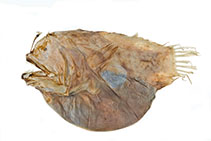| Family: |
Oneirodidae (Dreamers) |
| Max. size: |
17.5 cm SL (female) |
| Environment: |
bathypelagic; marine; depth range 549 - 1342 m |
| Distribution: |
Western Pacific: the Philippines and Magellan Seamounts (east of Mairiana Is.). |
| Diagnosis: |
Dorsal soft rays (total): 6-6; Anal soft rays: 4-4. No males and larvae are known. Diagnostic characters refer to metamorphosed females, which differ from other species in the family Oneirodidae by having an unusually deep caudal peduncle (21.6-23.8% SL); blunt and short snout, highly convex frontals forming an extremely short head (29.8-30.5% SL); few teeth in jaws (20-32 in the upper jaw, 20-31 lower). Metamorphosed females are also distinguished by the following set of characters: presence of vomerine teeth; well-developed sphenotic spines (length 3.4-3.6% SL), directed dorsolaterally; a stout symphysial spine on lower jaw; hyomandibular with double head; well-developed quadrate spine (length 4.5-5.0% SL); articular spine less than half length of quadrate spine; posterior margin of opercle deeply notched; long and narrow subopercle, dorsal end tapering to a point (posterior margin without indentation), ventral end oval in shape (no anterior spine or projection); caudal-fin rays with no internal pigmentation; illicium distinctly longer than length of esca bulb; pterygiophore of illicium emerging on snout from between fontal bones, anterior end exposed, posterior end concealed beneath skin; well-developed first dorsal-fin ray ; D 6; A 4; pectoral -fin rays 15-16; short and broad pectoral-fin lobe (length 8.6-8.9%SL) shorter than longest rays of pectoral fin (19.4-19.9% SL); skin apparently naked, no dermal spinules; darkly pigmented skin of caudal peduncle extending well past base of caudal fin (specimens 2:13.4-15.1 cm SL) (Ref. 51262). |
| Biology: |
|
| IUCN Red List Status: |
Least Concern (LC); Date assessed: 11 October 2018 Ref. (130435)
|
| Threat to humans: |
harmless |
Source and more info: www.fishbase.org. For personal, classroom, and other internal use only. Not for publication.

